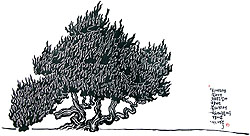Archives
Anderson Gallery to present "Korean Woodcuts"
By KRISTIN E.M. RIEMER
Reporter Contributor
"Korean Woodcuts," an exhibition comprised of 51 prints by 10 contemporary Korean artists working in traditional methods, will open tomorrow in the UB Anderson Gallery with a reception from 6-8:30 p.m. featuring traditional cuisine and music performed by a folk percussion band.

Yeunbok Ryu, Burning, 1997, black-and-white oil-based woodcut on Jang-ji natural paper
The exhibition was organized by Chunwoo Nam, an MFA candidate in the Department of Art, with assistance from Jackie Weng, a graduate student in the Department of Art History, and Arnez A. Hong, an undergraduate English major who served as editor and translator. The exhibition will remain on view through Feb. 15.
In conjunction with the exhibition, Nam, who is himself a Korean master printer, will offer a free demonstration of water-based woodcut techniques from 2-3:30 p.m. Saturday in the Anderson Gallery. Seating is limited, so interested parties should call 829-3754 to reserve a spot. Dates for additional woodcut workshops with Nam will be announced.
The exhibition coincides with a performance of the Korean masked dance play, "Dongnae Yaryu," which will be presented at 8 p.m. Nov. 21 in the Center for the Arts, North Campus, as part of International Education Week at UB. "Dongnae Yaryu" is a Korean art form in which dance, words and body movement come together as a fully developed drama. See item in the "People etc." column of this issue of the online Reporter for more details.
"Korean Woodcuts" also coincides with the closing of the Korean Centennial, a celebration marking the 100-year anniversary of the immigration of the first 86 Koreans to the United States in 1903. Now more than 2 million strong, Korean Americans continue to share their bicultural roots and work to enhance cross-cultural understanding and Korean-American relations. Visit http://www.koreancentennial.org for more information about the centennial.
The exhibition, with its examples of traditional techniques by contemporary artists, will bring much to the table in terms of understanding Korean culture, Nam and Weng say These artists—as artisans or as social advocates—use their work to participate in active movements against dictatorship and the militant government. Instead of using avant-garde propaganda to convey their political ideology and the nation's desire for democracy, they use their formal training to blend traditional elements, including aspects of nature (animal and plant-life motifs), Buddhist-influenced figures and ancient Korean calligraphy, with popular aesthetics to portray contemporary life, the organizers note. The result is work that, in some cases, reflects disconcerting emotions toward the government, but also serves to preserve Korea's cultural, historical and social significance in the Asian continent, they add.
The artists—Bi-Pa Jung, Jongeuk Kim, Joonkwon Kim, Kyungyoung Oh, San Namkung, Seokwhan Kim, Seaon-Wung Hong, Yeogeol Yoon, Yeunbok Ryu and Young-Jae Im—all were born shortly after the outbreak of the Korean War. Like the effects that Japanese colonization had on Korea earlier in the century, this event was a turning point as it created a massive division within the nation; thus, the "Land of the Morning Calm" has been catastrophically separated into two separate parts due to political power struggles between the North and the South, Nam and Weng say.
These artists continue to research and use the traditional style of printmaking in hopes of reconstructing Korea's social identity—mirroring the Koryo Dynasty's endeavors to preserve Buddhist scriptures that survived arson between 1236-1251—by attempting to protect culture that has suffered greatly from outside influences and oppression.
"Overall," the organizers say, "these social artists succeed in manifesting the woodblock printmaking as a powerful artistic medium and as a tool to open the eyes of the public of their surrounding social environment."
The Anderson Gallery is located on Martha Jackson Place, off Englewood and Kenmore avenues near the South Campus. Gallery hours are 11 a.m. to 5 p.m. Wednesday through Saturday, and 1- 5 p.m. on Sunday. Call 829-3754 for more information.
